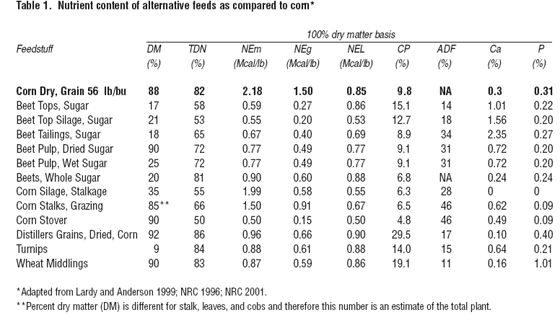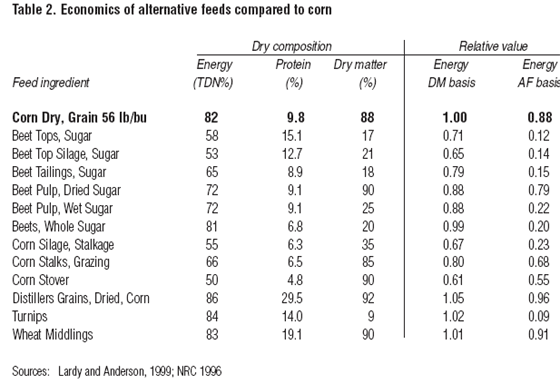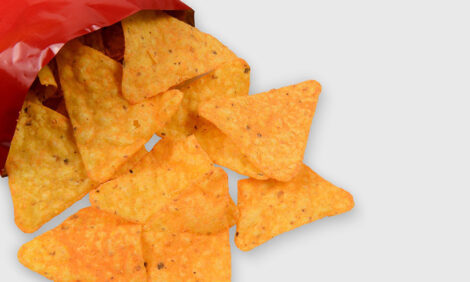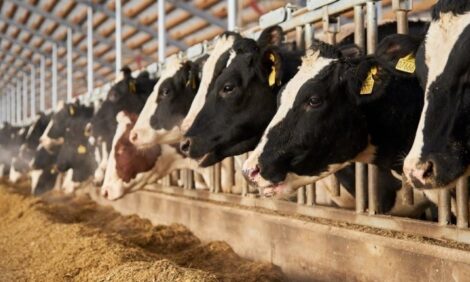



Cattle, Corn, and Alternative Feeds
By Rebecca Schafer, livestock Extension educator Alvaro Garcia, Extension dairy specialist - With the high prices of corn, many producers are looking for energy and protein alternatives to replace either all or a portion of the corn they have been feeding.
Feed is the largest single production expense for cattle operations. Beef cow-calf producers rely heavily upon forages, supplementing with energy or protein to meet nutritional needs. Dairy producers rely on nutrient-dense rations to fulfill the energy requirements of high producing dairy cows. This is usually accomplished with digestible forages and the inclusion of as much grain as compatible with an optimum rumen function.
Alternative and byproduct feeds that provide supplemental nutrition are often available at a fairly competitive price in eastern South Dakota (Table 1). The feeds are economically comparable to corn grain (Table 2) and can replace some or all of the corn grain.
Corn stalks
Description: After harvest, approximately 50% of the weight of the total corn plant is left as residue (stalk, leaf, cob, and husk). According toWright and Tjardes (2004), most farm business management and Extension personnel consider grazed crop residues to be among the lowest cost feed resources.Stalks can be baled or you can turn the cattle into the field to graze. One acre of corn stalks will provide approximately 1.5 to 2 animal unit months (AUM) of grazing. This means that one acre of corn residue can supply enough forage to sustain a 1,000-lb cow or animal equivalent for 1.5 to 2 months.
Storage and feeding: Corn stalks are comparable in energy content to average hay on a dry matter basis. They can be grazed in the field or baled, particularly as large packaged bales, for self-feeding.
If stalks are grazed, cattle will consume any remaining grain first, and then the leaves, and lastly, cobs and stalks. There is a slight risk for digestive problems including bloat, acidosis, and founder; the risk varies greatly depending on the amount of grain left in the field (Wright and Tjardes 2004).
Distillers grains
Description: Corn is the most widely used grain in ethanol production, and distillers grains are byproducts of this process.When labeled "distillers grains with solubles," the feed also contains the solubles of fermentation. Distillers grains are available in wet and dry form.Storage and feeding: Distillers grains can be fresh, dried, or ensiled; however, the dried product is the easiest to handle and store and the wet product can deteriorate rapidly in hot weather (Wahlberg 2005) with a shelf life of 7 to 10 days or less.
Distillers grains are a good source of protein and energy for dairy rations; they are also a good source of phosphorus depending on the needs in the diet (Schingoethe et al. 2002). They are relatively competitive with other feeds as an energy source.
Because of the high protein content of distillers grains, they are generally considered as protein sources


(Wahlberg 2005) and can be fed in well-formulated diets at up to 20% of diet dry matter (DM; Anderson et al. 2006; Kleinschmit et al. 2006). SDSU research has demonstrated increased milk production when cows were fed 5% of the diet DM as condensed distillers solubles (Schingoethe et al. 2002).
If forages are mostly corn silage, then up to 30% of a ration can be fed as dried distillers grains (DDGS) DM basis, however, additional ruminally degradable protein and lysine may be needed in the diet (Schingoethe et al. 2002).
Wheat middlings
Description:Wheat middlings are a byproduct of milling wheat for flour. Midds consist of fine particles of flour, bran, shorts, and germ. Wheat midds are a moderately palatable feedstuff that is rich in protein, phosphorus, and potassium, yet low in calcium. Wheat midds also contain 92% of the energy value of corn and are higher in protein than corn grain (Amaral-Phillips and Hemken 2006).Storage and feeding:When using wheat midds as a substitute for corn, purchase in bulk quantities. Due to their bulkiness, they should be stored in a commodity bin or shed flat.Wheat midds weigh approximately 20 lb per cubic foot.
Upper feeding limits of wheat midds are 10 to 15 lb per cow per day (Shaver 2007). Dairy producers can substitute wheat middlings for some of the higher-cost feed ingredients in rations for early-lactation cows (Marx and Kurtz 2001). Wheat midds can be incorporated into the dairy diet as 25% to 40% of the grain ration or 15% to 20% of the total DM ration (Shaver 2007). Because of their rapid fermentation in the rumen, it is important to verify the effective fiber in the diet to avoid potential digestive upsets such as acidosis and/or displaced abomasums.
Turnips
Description: Turnips are root vegetables commonly grown in temperate climates for their white, bulbous taproot. They are fast growing and are related to radishes, cabbages, cauliflowers, broccoli, and brussels sprouts. Storage and feeding: Turnips grow well in cold climates and can be stored for several months after harvest. They retain their nutrients late into the fall and are good in providing high quality and quantity forage for grazing livestock in the fall (Smart 2004). Turnips also produce high-quality forage when harvested before heading. Livestock eat the stems, leaves and roots of turnip plants. Cattle will also dig the turnips up out of the ground.Be careful when moving cattle from lesser quality pasture onto turnips. A strategy would be to slowly change cattle over, beginning with a few hours per day over a 10-day period (Smart 2004). When feeding whole turnips, choking may be a potential problem.
Sugar beet byproducts
Description: Beets are grown primarily for their enlarged bulbous root, although the greens can be eaten or used for cattle feed along with the roots. Byproducts include molasses and beet pulp. Additionally, rejected beets (small, broken or damaged) are available to producers as beet tailings. Because tailings are separated only during harvest, their availability is limited to late in the fall. Beet pulp may be available wet during harvest and winter, but it is available dry throughout the year.Storage and feeding: Dry pelleted pulp can be stored in bins or quonsets; wet pulp can be stored in silage bags, trench silos, or bunker silos (Lardy and Anderson 1999). Dried beet pulp can be up to 30% of the diet on a DM basis (Maiga et al. 1997).
It cannot be emphasized enough that trace mineral levels need to be monitored when feeding a high percent of pulp or when feeding with an alfalfa ration. Due to the high calcium and low phosphorus levels, pressed beet pulp can aggravate the Ca:P ratios in alfalfa diets. There is usually not a problem with rumen fermentation when feeding beet pulp, but take care with other beet byproducts; the beet byproduct used depends on how much can be fed.
Beet tailings and wet pulp contain approximately 75% to 80% moisture; silage contains about 60%. The high moisture content limits how far these byproducts can be trucked. Choking is a potential problem to be cautious of when feeding whole beets or tailings. Depending on how much soil is mixed in with the beets, tailings have a feeding value similar to or higher than corn silage on a DM basis (Lardy and Anderson 1999).
Beet tops should be allowed to partially dry in the field before ensiling; mixing the beets with other feeds or for-ages when ensiling will reduce the sticky consistency (due to the sugar content) of the silage (Lardy and Anderson 1999). Ensiling beets also reduces the amount of nitrates in the beet tops; however, it would be a good idea to have the silage tested for nitrates before feeding.
Beet pulp can replace either part of the grain or part of the forage in a dairy ration. Compared to corn, beet pulp contains 85 to 90% energy, similar crude protein, but a much higher and more digestible fiber (Maiga et al. 1997). Beet pulp may contain some molasses (about 3%), which adds to its energy value and palatability (Maiga et al. 1997). Upper feeding limits are about half of the grain concentrate or 8 to 15 lb of DM per cow per day (Shaver 2007). Dried sugar beet pulp can be included up to 30% of the diet on a DM basis (Maiga et al. 1997).
Summary
There are several ways to look at the cost effectiveness of alternative feeds. One way is to compare their relative feed value (RFV) to that of corn (Table 2). The relative energy on a dry matter basis and as-fed basis for these alternative feeds and by-products are comparable to that of corn grain.Base your decision about using alternative feeds on economics, local availability, and feasibility of storage, handling, and feeding.
The choice to replace all or some of the corn in your cattle’s feed rations also depends upon what your goals and needs are. Feeding corn may still be a better option despite current prices.
It is also important to think about the nutrient composition of alternative feeds (Table 1). Due to the nature of some of these alternative feeds, it would be a good idea to have a lab analysis done so you would know the exact value of the alternative feed or by-product. According to Myer and Hall (2003), there are 12 factors one should keep in mind when looking for alternative feeds for cattle (Table 3).
Table 3. Factors when looking for alternative feeds
- Accurate identification of the alternative feed
- Availability and consistency of availability
- Nutrient composition and nutrient availability
- Consistency of composition
- Suitability
- Perishability
- Freedom from health hazards
- Special handling, processing, and storage requirements
- Effect on end product
- Storage space
- Legality
- Cost
February 2007


